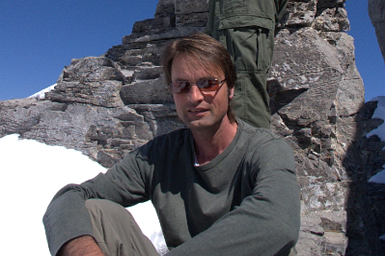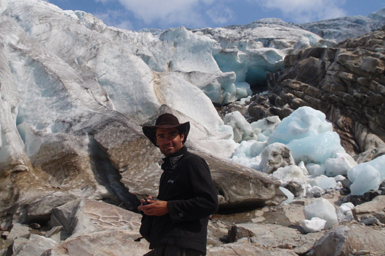
The Quark Nova Project (QNP) is a group of scientists based out of the University of Calgary who are dedicated to the investigation of quark novae (QNe). A quark nova (QN) is the violent explosion resulting from the conversion of a neutron star core to quark matter through a process known as quark deconfinement. The result is a star made entirely of quarks; the quark star. This process would release immense amounts of energy, perhaps explaining the most energetic explosions in the universe; rough calculations have estimated that as much as 1047 joules of energy could be released from the phase transition inside a neutron star. Quark-novae explain a multitude of astrophysical phenomena from gamma ray bursts through super-luminous super novae.
Our understanding of the formation of elements, particularly those heavier
than iron, under the current paradigm of nucleosynthesis in supernova
shocks with minor contributions from low-mass stars and neutron star
mergers is severely strained. The energy required to produce the heavy
element abundance seen in our Sun is too great for supernovae alone.
While the addition of nucleosynthesis from neutron star mergers helps,
these events occur much too infrequently to account for the peaks
in the observed heavy element abundance. All recent work in the field
of astrophysical nucleosynthesis has pointed to the need for another
site for heavy element formation, such as that provided by the Quark-Nova.
In addition to the heavy element mystery, other unexplained observations
including titanium enriched supernovae, early chemical enrichment
and the lithium plateau have placed severe constraints on current
astrophysical models. For years these models have tried, but ultimately
failed at explaining the observations. The time is ripe to explore
fresh, new ideas in an attempt to solve these puzzles. The Quark-Nova
is an exciting new mechanism for astrophysical nucleosynthesis, the
potential of which has only begun to be realized. Preliminary studies
of different Quark-Nova scenarios have provided remarkable insight
into these astrophysical problems and more detailed investigations
are eagerly anticipated.
The theory of quantum chromodynamics (QCD) describes the strong force
and how quarks and gluons interact. QCD is a well-developed theory
but lacks experimental verification. Large, costly experiments at
accelerators such as the Relativistic Heavy Ion Collider (RHIC), and
the Facility for Antiproton and Ion Research (FAIR) are currently
testing the theory on a femtosecond scale. On the other hand, studying
neutron stars and how they lead to Quark-Novae provide a natural stable
environment to test QCD. Studying these phenomena will therefore lead
to a greater understanding of QCD which works hand in hand with laboratories
here on Earth by providing clues as to which energy regimes future
experiments should target.
Recent astronomical observations of objects including super-luminous
supernovae, an increasing number of Extremely Metal-poor (EMP) stars,
constraints on reionization of the physics of the first stars, and
gamma-ray bursts (GRBs) may all share a common thread; the Quark-Nova.
These recent developments in QCD and astrophysics connect naturally
with a need to understand the role of quarks and nuclei in astrophysics
- the Quark-Nova model provides the ideal arena to explore these ideas.
The Quark Nova has been featured by several media outlets:
Our research into "Dark Energy" (DE) is not about trying to discover what it is, but rather looking at how the Quark Nova can skew observations that claim to support its existence. By observing Type Ia supernovae, astronomers in the late 1990's were able to conclude that the Universe is not only expanding, but doing so at an ever increasing rate. This required the existence of an unknown, repulsive force which astronomers dubbed "Dark Energy". The nature of DE is still unknown to this day despite countless man-hours and an investment of millions of dollars. The discovery of DE depended on two "properties" of Type Ia supernovae: I) They are standardizable candles, i.e. their distance can be linked to their observed brightness and II) they are standardizable at all red-shifts, i.e. across all time.
Consider a close neutron star (NS) /white dwarf (WD) binary system. Mass will transfer from the WD onto the NS, pushing the NS over the critical mass and it will experience a QN. The ejecta from the QN will hit the WD, causing it to explode as a Type Ia supernova (the spectrum will be almost indistinguishable from a Chandrasekhar type explosion). The Type Ia explosion will quickly engulf the remnant quark star which will add additional spin-down energy to the envelope. The higher the spin rate of the quark star, the more energy will be imparted. This spin-down energy will alter the light curve of the Type Ia explosion.
This scenario neatly explains the different types of Type Ia light curves observed and also the empirical Phillips relation which is the primary ways in which Type Ia supernovae are standardizable. We have shown in our work that Type Ia supernovae resulting from the aforementioned scenario are NOT standardizable and indeed vary over distance (red-shift). This has enormous consequences if the QN is responsible for the majority of Type Ia events, and removes the need for dark energy to explain Type Ia observations.
Super-Luminous Super-Novae (SLSNe) are supernovae (SNe) which are exceptionally bright. We model SLSNe using a dual-shock Quark Nova (QN) model. In this scenario a neutron star experiences a QN a few weeks after the initial supernova explosion. The QN ejecta is travelling faster than the SN ejecta and the two collide within a month. The SN ejecta is shocked and re-energized to temperatures above 1x108 K. Since the ejecta is now much larger (it has had a month to expand) it becomes extremely bright when shocked, giving rise to a SLSNe.
Soft Gamma Repeaters (SGRs) and Anomalous X-Ray Pulsars (AXPs) are observationally thought to be related phenomena. These are objects that emit large bursts of gamma-ray and X-ray radiation at seemingly random intervals. We model AXPs and SGRs as an isolated quark star surrounded by either a degenerate shell of fall-back quark nova ejecta (SGRs) or a degenerate Keplerian disk of fall-back quark nova ejecta (AXPs). In both cases, the bursts are triggered when chunks of the shell/disk break off and accrete onto the quark star. The material is immediately converted to quark matter, releasing an enormous amount of energy which we observe as the burst. The size and location of the chunk determines the intensity and timing of the burst.

Rachid's main research interests are in Astrophysical Jets and Compact stars. His investigations of astrophysical jets consists of 2D and 3D High Performance Computational studies of (relativistic and non-relativistic) Magneto-Hydrodynamic Jets from newly born stars and black holes. Rachid has also investigated neutrino and photon emission mechanisms in quark matter with implication to explosive astrophysics.

Denis' main areas of research are: Compact Objects, X-ray Binaries and Supernova Remnants. He also contributes to instrument development, most recently the detectors for the UVIT telescopes on the ASTROSAT space mission.

Nico is a post-doc at the University of Calgary studying the morphology of proto and planetary nebulae in addition to quark novae. Nico is co-author of the Shape software which assists in 3D modeling of astrophysical phenomena. Nico is also interested in the development of astronomical software that is intuitive, powerful and easy to use. Nico is also the webmaster of the QNP site.

As a PhD student at the University of Calgary Matt investigates the spectroscopic behavior of quark novae and quark stars. Along with this work Matt studies nucleosynthesis of heavy elements during the quark nova explosion.

Brian's research is focused on the transition from hadronic (nucleated) matter to a quark-gluon plasma (QGP). Most recently he has been exploring the process where hadronic matter is "burnt" into strange-quark matter (SQM). To do this Brian has developed a computer program that numerically solves the equations of (fully-compressible hydrodynamical) burning to strange-quark matter. He has found that the inclusion of neutrinos is incredibly important, as they can result in a new kind of instability.

Jan's research interests are focused around three broad topics: (i) Gamma ray bursts: investigating and developing models for the inner engine for both short and long gamma ray bursts based on a quark star as the central engine. (ii) Fluid dynamics: hydrodynamic and magnetohydrodynamic 3D simulations of protostellar jets, jets from black holes, merging white dwarfs, common envelopes, pulsar wind nebula bow shocks. (iii) Physics of compact stars: studying the structure of rapidly rotating neutron stars and investigating suitable conditions that can lead to quark novae.

Prashanth's research interests center on theoretical and computational challenges at the interface of Nuclear Physics and Astrophysics. He studies the properties of Neutron stars, particularly their interior composition and astrophysical signals of exotic phases such as color superconducting matter. Prashanth is also interested in investigating new sites for r-process nucleosynthesis such as the Quark-Nova and the connection between Neutron stars and gravitational waves. Some of his technical tools are: Field Theory, Particle Physics and Numerical Programming.

Wolfgang works mainly on the interface between theoretical studies of hydrodynamic flows and their observations, developing effective ways to directly compare observations of particular objects with complex theoretical models. He has developed models for the kinematics and brightness variations in relativistic helical radio jets and the hydrodynamic interaction of radio jets with the interstellar medium in Seyfert galaxies.

Amir is currently working on a nuclear spallation code to help determine the abundance of elements created in a dual shock Quark Nova.

Zachary is doing an MSc in astrophysics at the University of Calgary. He has been doing research on nucleosynthesis in supernova explosions, focusing specifically the extent to which supernova are able to contribute to the production of heavy elements in the r-process.

Luis is a masters student at the University of Calgary interested in the nature of the engines powering Superluminous Supernovae (SLSNe). As an undergraduate student he worked for the Quark-Nova group looking at dark matter seeding and other mechanisms that could seed the transition from Hadronic to Quark matter. Calgary.

For his Masters Degree, Camille worked in Calgary on the neutron captures in very neutron rich environment and studied the r-process in the context of Quark-Novae. As a PhD student at the CEA or Center for Atomic Energie, he investigates the turbulent thermonuclear combustion in Supernovae type Ia. Studing both subsonic (deflagration) and supersonic (detonation) flame propagation and its interaction with turbulence, the main objectif being to simulate consitently a Deflagration to Detonation Transition (DDT), which would help models fit the observations.
This animation shows how a massive star ends its life through a supernova followed by a quark nova explosion. It also demonstrates the reheating of the supernova remnant via a dual shock quark nova giving rise to a superluminous supernova.
This animation shows a binary system where the neutron star goes Quark Nova. This scenario is part of an investigation into low-mass x-ray binaries with massive neutron stars to explain soft-hard gamma-ray bursts.
On January 13 2011, Slacker Astronomy interviewed Rachid Ouyed concerning quark novae.
At the Quark Nova Project we strive to create easy to use, platform independant software that is freely available to the public. Please feel free to use any of the programs listed below, and if you have questions or would like to see featured added please let us know!
SiRop is an evolution of an earlier r-process code (r-Java) which was developed specifically to perform sensitivity studies. In other words, we wanted a program that we could use to run automated or “script-like” execution of code. This involved a complete rework of the user interface an addition of code to perform automated queueing, execution and analysis of r-process simulations
Shape is a morpho-kinematic modeling and reconstruction tool for astrophysical objects. With this software you can quickly construct 3D model structures and directly compare them with data in order to assist in the interpretation of observations. From such a 3D structure model with a model velocity field and emission properties, it generates images and position-velocity (pv) diagrams, channel maps, light echoes, light curves and one dimensional spectral line shape, to mention a few. Wavelength dependent radiation transfer for line emission and scattering on dust is also possible.
We present r-Java 2.0, an r-process nucleosynthesis code equipped with a simple-to-use graphical user interface (GUI) that solves a full reaction network of over 8000 nuclei. Built to be an instrument for the nuclear physics and astrophysics community, r-Java 2.0 allows users to test the effects of varying nuclear reaction rates as well as study the r-process in a host of different astrophysical environments. On top of solving an r-process reaction network over a large range of input parameters r-Java 2.0 computes; nuclear statistical equilibrium (NSE) distributions, fission mass fragmentation and allows for the investigation of individual nuclear reactions.
Digiget is a digitization program that converts graphs from images (perhaps from a publication) to ascii data points. It has an easy to use interface and is remarkably powerful. The current version is beta, so please let us know if you have any problems or would like to see features added.
BURN-UD is a code that solves the equations of hydrodynamical combustion. It solves the equations explicitly in time using a fourth-order Runge-Kutta scheme; spatial derivatives are treated separately, as per the Method of Lines. The spatial derivatives include advection which is treated with a third-order upwinded, ?ux-limited, ?nite-volume scheme and difusion and pressure terms, which are second-order, not upwinded, and treated separately from the advection terms (ie. not ?ux-limited).
JETGET is a visualization and analysis tool we developed for accessing data stored in Hierarchical Data Format (HDF) and ASCII files. Although JETGET has been optimized to handle data output from jet simulations using the Zeus code from NCSA, it is also capable of analysing other data output from simulations using other codes. JETGET can select variables from the data files, render both two- and three-dimensional graphics and analyse and plot important physical quantities. Graphics can be saved in encapsulated Postscript, JPEG, VRML or saved into an MPEG for later visualization and/or presentations. An example of use of JETGET in analysing a 3-dimensional simulation of jets emanating from accretion disks surrounding a protostar is shown. The strength of JETGET in extracting the physics underlying such phenomena is demonstrated as well as its capabilities in visualizing the 3-dimensional features of the simulated magneto-hydrodynamic jets. The JETGET tool is written in Interactive Data Language (IDL) and uses a graphical user interface to manipulate the data. The tool was developed on a LINUX platform and can be run on any platform that supports IDL.
RoLo (Roche Lobe) is a tool to calculate the radius and potential of the Roche Lobe. It does this for any specified direction, and also gives some other commonly used quantities (such as the Lagrange points). The calculator is valid for any mass ratio q between 0.01 and 100. The coordinates are spherical-polar (R, theta, phi) centered on one star (M1), with the x-axis (theta=pi/2, phi=0) pointing towards the other star (M2). The mass ratio is defined as q=M2/M1. Distances are given in units of the binary separation, a. A circular orbit is assumed. How does it work? Values of Lagrange points and potentials were separately calculated for about 150 different values of q, accurate to 8 digits, and stored in a Table. The calculator interpolates for intermediate values of q. To get the radius in an arbitrary direction, a root-finding algorithm finds the point which has a specific value of the potential for the desired theta and phi coordinates. The accuracy is 8 digits at a Tabulated value, but is at least 4 digits for intermediate values of q. For a physical system, one knows the actual values of the masses M1 and M2. Either one specifies the binary separation a, or calculates it from the orbital period P, using Kepler's law. The dimensionless radius is converted into physical units by multiplying by a. To run, please download the .zip file below and follow the instructions within.
Authors: Denis Leahy and Janet Leahy
SNRPy (Super Nova Remnant Python )is a freely available Python code for modelling supernova remnant (SNR) evolution. This software is intended for two purposes: to understand SNR evolution; and to use in modelling observations of SNR for obtaining good estimates of SNR properties. It includes all phases for the standard path of evolution for spherically symmetric SNRs. In addition, alternate evolutionary models are available, including evolution in a cloudy ISM, the fractional energy loss model, and evolution in a hot low-density ISM. The graphical interface takes in various parameters and produces outputs such as shock radius and velocity vs. time, SNR surface brightness profile and spectrum. To run, please download the .zip file below and follow the instructions within.
Authors: Denis Leahy, Jacqueline Williams, Bryson Lawton
It is believed that whenever a "strangelet" of quark matter touches ordinary matter (us humans for example) it would convert it entirely to quark matter. This would imply that if deconfined quarks (freed quark matter) come to exist anywhere in the universe the consequence would be disastrous and the entire universe would become a universe of quarks. However, it is important to understand that a "nugget" of quark matter is positively charged which means that it would repel normal matter. Only inside a neutron star where the conversion is most likely to occur since neutrons are neutral and would naturally interact with the quark matter and become converted. This conversion is explosive in nature which should manifest itself as the Quark-Nova. "Strangeness is the cancer of a neutron star".
If, as we have said, pollution by quark nuggets would convert all of the neutron stars then one begs the question of whether neutron stars and quark stars can co-exist. However, there isn't enough of these quark nuggets roaming around to be captured by neutron stars and convert them. In other words, an unambiguous detection of an ordinary neutron star would not rule out the existence of quark stars.
The delay between the SN explosion and the QN explosion can give us vital clues about the density at which quarks become free from the nucleons. This density, where the transition from the hadronic matter (protons, neutrons, atoms as we know them) to the world of free quarks, is almost impossible to derive from first principles because of the extremely complex equations of quantum-chromo-dynamics (the theory that studies quark matter). The Quark-Nova sits at the interface between the two world and discovering one is essentially finding the door that will allow us to enter and understand the world of quarks. The discovery of a Quark-Nova (via the light it emits or nuclear elements it ejects) would imply the existence of quark stars which will become the laboratory for studying quark matter.
MHD at the Quark Nova Project - The Magneto-Hydrodynamics (MHD) division of the Quark Nova Project (QNP) is a group of scientists based out of the University of Calgary who develop code to produce 2D and 3D simulations of outflows from YSOs
University of Calgary - The University of Calgary is Canada’s leading next-generation university – a living, growing and youthful institution that embraces change and opportunity with a can-do attitude.
CAPCA - Computational Astrophysics at the University of Calgary
SHAPE - Images inspire us. Images lead to ideas. We made Shape as a tool to test inspirations. Play True or False. By finding out whether an idea works or not, either way, we deliver new insight into nature for ourselves and sometimes even for others. That is why with Shape we make images...and more...
PHAS - Department of Physics and Astronomy at the University of Calgary. The department is involved in a number of Research Areas that are supported by many provincial and national grants and fellowships making the department's per capita funding level the highest within the University of Calgary Faculty of Science. This allows the research groups in the department to have access to world-class experimental and computational facilities both here and at collaborating institutions, as well as state-of-the-art data sets.
RAO - Rothney Astrophysical Observatory at the University of Calgary. The Rothney Astrophysical Observatory (RAO) benefits the community through its dual roles as a University of Calgary research facility and as a public educational institution. The RAO’s primary purpose and service to the community is to provide a resource for science educators and to act as a support to science education in Alberta.
CSQCD - Compact stars in the QCD phase diagram